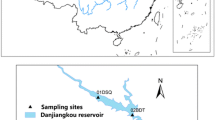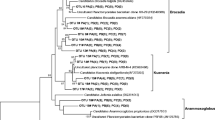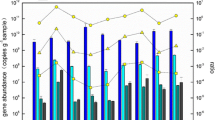Abstract
Autotrophic ammonia oxidizing microorganisms, which are responsible for the rate-limiting step of nitrification in most aquatic systems, have not been studied in tropical estuaries. Cochin estuary (CE) is one of the largest, productive, and monsoon-driven estuary in India opening into the southeast Arabian Sea. CE receives surplus quantities of ammonia through industrial and domestic discharges. The distribution of ammonia-oxidizing bacteria (AOB), ammonia-oxidizing archaea (AOA), and anaerobic ammonia-oxidizing bacteria (anammox) were studied using fluorescence in situ hybridization (FISH) and their relative contribution to the process as well as the governing factors were examined and reported for the first time from CE. The order of occurrence of these assemblages was β-proteobacteria (0.79 to 2 × 105 cells ml−1) > γ-proteobacteria (0.9 to 4.6 × 104 cells ml−1) > anammox (0.49 to 1.9 × 104 cells ml−1) > AOA (0.56 to 6.3 × 103 cells ml−1). Phylogenetic analysis of DGGE bands showed major affiliation of AOB to β-proteobacteria, while AOA was affiliated to Crenarchaeota. The abundance of AOB was mostly influenced by ammonia concentrations. The recovered ammonia oxidation rate of AOB was in the range of 45–65 %, whereas for AOA, it was 15–45 %, indicating that AOB were mostly responsible for the ammonia oxidation in CE during the study period. Overall, the present study provides an insight into the relevance and contribution of different groups of ammonia oxidizing bacteria in CE and emphasizes the need for further in depth studies across space and on season scale.










Similar content being viewed by others
References
Mulder A, Van de Graaf AA, Robertson LA, Kuenen J (1995) Anaerobic ammonium oxidation discovered in a denitrifying fluidized bed reactor. FEMS Microbiol Ecol 16:177–184
Venter JC, Remington K, Heidelberg JF, Halpern AL, Rusch D, Eisen JA, Wu D, Paulsen I, Nelson KE, Nelson W, Fouts DE, Levy S, Knap AH, Lomas MW, Nealson K, White O, Peterson J, Hoffman J, Parsons R, Baden-Tillson H, Pfannkoch C, Rogers Y-H, Smith HO (2004) Environmental genome shotgun sequencing of the Sargasso Sea. vol. 304, pp. 66–74
Francis CA, Michael Beman J, Kuypers MMM (2007) New processes and players in the nitrogen cycle: the microbial ecology of anaerobic and archaeal ammonia oxidation. ISME J 1:19–27
Caffrey JM, Bano N, Kalanetra K, Hollibaugh JT (2007) Ammonia oxidation and ammonia-oxidizing bacteria and archaea from estuaries with differing histories of hypoxia. ISME J 1:660–662
Cébron A, Berthe T, Garnier J (2003) Nitrification and nitrifying bacteria in the lower Seine River and estuary (France). Appl Environ Microbiol 69:7091–7100
Bernhard AE, Tucker J, Giblin AE, Stahl DA (2007) Functionally distinct communities of ammonia oxidizing bacteria along an estuarine salinity gradient. Environ Microbiol 9:1439–1447
Nicholls JC, Trimmer M (2009) Widespread occurrence of the anammox reaction in estuarine sediments. vol. 55, pp. 105–113
Rich JJ, Dale OR, Song B, Ward BB (2008) Anaerobic ammonium oxidation (anammox) in Chesapeake Bay sediments. Microb Ecol 53:311–320
Trimmer M, Nicholls JC, Deflandre B (2003) Anaerobic ammonium oxidation measured in sediments along the Thames estuary, United Kingdom. Appl Environ Microbiol 69:6447–6454
Prosser JI, Nicole GW (2008) Relative contributions of archaea and bacteria to aerobic ammonia oxidation in the environment. Environ Microbiol 10:2831–2841
Gupta GVM, Thottathil SD, Balachandran KK, Madhu NV, Madeswaran P, Nair S (2009) CO2 supersaturation and net heterotrophy in a tropical estuary (Cochin, India): influence of anthropogenic effect. Ecosystems 12:1145–1157
Miranda J, Balachandran KK, Ramesh R, Wafar M (2008) Nitrification in Kochi backwaters. Estuar Coast Shelf Sci 78:291–300
Grasshoff K (1983) Methods of seawater analysis. Verlag Chemie, Weinheim
Glockner FO, Fuchs BM, Amann R (1999) Bacterioplankton composition of lakes and oceans: a first comparison based on fluorescence in situ hybridization. Appl Environ Microbiol 65:3721–3726
Boström KH, Simu K, Hagström Å, Riemann L (2004) Optimization of DNA extraction for quantitative marine bacterioplankton community analysis. Limnol Oceanogr Methods 2:365–373
Kowalchuk GA, Stephen JR, De Boer W, Prosser JI, Embley TM, Woldendorp JW (1997) Analysis of ammonia-oxidizing bacteria of the beta subdivision of the class Proteobacteria in coastal sand dunes by denaturing gradient gel electrophoresis and sequencing of PCR-amplified 16S ribosomal DNA fragments. Appl Environ Microbiol 63:1489–1497
Taylor AE, Zeglin LH, Sandra D, Myroid DD, Bottomley PJ (2010) Evidence for different contributions of archaea and bacteria to the ammonia-oxidizing potential of diverse Oregon soils. Appl Environ Microbiol 76:7691–7698
Madhu NV, Jyothibabu R, Balachandran KK, Honey UK, Martin GD, Vijay JG, Shiyas C, Gupta GVM, Achuthankutty CT (2007) Monsoonal impact on planktonic standing stock and abundance in a tropical estuary (Cochin Backwaters – India). Estuar Coast Shelf Sci 73:54–64
Martin GD, Jyothibabu R, Madhu NV, Balachandran KK, Nair M, Muraleedharan KR, Arun PK, C.K H, Revichandran C (2013) Impact of eutrophication on the occurrence of Trichodesmium in the Cochin backwaters, the largest estuary along the west coast of India. Environmental Monitoring and Assessment 185: 1237–1253.
Naik H (2000) Nutrient budgets for Periyar estuary, Kerala. Regional training workshop on biogeochemical budgeting and socio-economic modeling for coastal scientists. APN/SASCOM/LOICZ, Colombo
Balachandran KK, Laluraj CM, Nair M, Joseph T, Sheeba P, Venugopal P (2005) Heavy metal accumulation in a flow restricted, tropical estuary. Estuar Coast Shelf Sci 65:361–370
Ram ASP, Nair S, Chandramohan D (2003) Seasonal shift in net ecosystem production in a tropical estuary. Limnology and Oceanography. 1601–1607
Sarma VVSS, Prasan VR, Kumar BSK, Rajeev K, Devi BMM, Reddy NPC, Sarma VV, Kumar MD (2010) Intra-annual variability in nutrients in the Godavari estuary, India. Cont Shelf Res 30:2005–2014
Mukhopadhyay SK, Biswas H, De TK, Jana TK (2006) Fluxes of nutrients from the tropical river Hooghly at the land-ocean boundary of Sundarbans, NE coast of Bay of Bengal, India. J Mar Syst 6:9–21
Thottathil SD, Balachandran KK, Gupta GVM, Madhu NV, Nair S (2008) Influence of allochthonous input on autotrophic–heterotrophic switch-over in shallow waters of a tropical estuary (Cochin estuary), India. Estuar Coast Shelf Sci 78:551–562
Bouvier TC, de Giorgio PA (2002) Compositional changes in free living bacterial communities along a salinity gradient in two temperate estuaries. Limnol Oceanogr 47:453–470
Crump BC, Armbrust EV, Baross JA (1999) Phylogenetic analysis of particle-attached and free living bacterial communities in the Columbia River, its estuary, and the adjacent coastal ocean. Appl Environ Microbiol 65:3192–3204
Crump BC, Hopkinson CS, Sogin ML, Hobbie JE (2004) Microbial biogeography along an estuarine salinity gradient: combined influences of bacterial growth and residence time. Appl Environ Microbiol 70:194–1505
Tourna M, Freitag TE, Prosser JI (2010) Stable isotope probing analysis of interactions between ammonia oxidizers. Appl Environ Microbiol 76:2468–2477
Cao H, Hong Y, Li M, Gu J-D (2011) Diversity and abundance of ammonia-oxidizing prokaryotes in sediments from the coastal Pearl River estuary to South China Sea. Antonie Van Leeuwenhoek 100:545–556
Santoro AE, Francis CA, de Sieyes NR, Boehm AB (2008) Shifts in the relative abundance of ammonia-oxidizing bacteria and archaea across physicochemical gradients in a subterranean estuary. Environ Microbiol 10:1068–1079
Schmid MC, Risgaard-Petersen N, Van De Vossenberg J, Kuypers MMM, Lavik G, Petersen J, Hulth S, Thamdrup B, Canfield D, Dalsgaard T, Rysgaard S, Sejr MK, Strous M, Op den Camp HJM, Jetten MSM (2007) Anaerobic ammonium-oxidizing bacteria in marine environments: widespread occurrence but low diversity. Environ Microbiol 9:1476–1484
Rysgaard SR, Glud RNH, Rigaard-Petersen N, Dalsgaard T (2004) Denitrification and anammox activity in Arctic marine sediments. Limnol Oceanogr 49:1493–1502
Schmidt I, Sliekers O, Schmidt M, Cirpus I, Strous M, Bock E, Gijs Kuenen J, Jetten MSM (2002) Aerobic and anaerobic ammonia oxidizing bacteria competitors or natural partners. FEMS Microbiol Ecol 39:175–181
Wankel SD, Mosier AC, Hansel CM, Paytan A, Francis CA (2011) Spatial variability in nitrification rates and ammonia oxidizing microbial communities in the agriculturally impacted Elkhorn Slough estuary, California. Appl Environ Microbiol 77:269–280
Hatzenpichler R (2012) Diversity, physiology, and niche differentiation of ammonia-oxidizing Archaea. Appl Environ Microbiol 78:7501–7510
Bernhard AE, Landry ZC, Blevins A, de la Torre JR, Giblin AE, Stahl DA (2010) Abundance of ammonia-oxidizing Archaea and Bacteria along an estuarine salinity gradient in relation to potential nitrification rates. Appl Environ Microbiol 76:1285–1289
Jin T, Zhang T, Ye L, Lee OO, Wong YH, Qian PY (2011) Diversity and quantity of ammonia oxidizing Archaea and Bacteria in sediment of the Pearl River estuary, China. Appl Microbiol Biotechnol 90:1137–1145
De Corte D, Yokokawa T, Varela MM, Agogue H, Herndl GJ (2008) Spatial distribution of Bacteria and Archaea and amoA gene copy numbers throughout the water column of the Eastern Mediterranean Sea. ISME J 3:147–158
Jiang L, Zheng Y, Chen J, Xiao X, Wang F (2011) Stratification of archaeal communities in shallow sediments of the Pearl River Estuary, South China. Antonie Van Leeuwenhoek 99:739–751
Costa E, Perez J, Kreft J-U (2006) Why is metabolic labour divided in nitrification. Trends Microbiol 14:213–219
Schramm A (2003) In situ analysis of structure and activity of the nitrifying community in biofilm, aggregates, and sediments. Geomicrobiol J 20:313–333
Mobarry BK, Wagner M, Urbain V, Rittmann BE, Stahl DA (1996) Phylogenetic probes for analyzing abundance and spatial organization of nitrifying bacteria [published erratum appears in Appl Environ Microbiol 1997 Feb;63(2):815]. vol. 62, pp. 2156–2162
Okabe S, Satoh H, Watanabe Y (1999) In situ analysis of nitrifying biofilms as determined by in situ hybridization and the use of microelectrodes. vol. 65, pp. 3182–3191
Sliekers A, Haaijer S, Stafsnes M, Kuenen J, Jetten M (2005) Competition and coexistence of aerobic ammonium- and nitrite-oxidizing bacteria at low oxygen concentrations. Appl Microbiol Biotechnol 68:808–817
Amann R, Binder BJ, Olson RJ, Chisholm SW, Devereux R, Stahl A (1990) Combination of 16S rRNA-targeted oligonucleotide probes with flow cytometry for analyzing mixed microbial populations. Appl Environ Microbiol 56:1919–1925
Obarry BK, Wagner M, Urbain V, Rittmann BE, Stahl A (1996) Phylogenetic probes for analyzing abundance and spatial organization of nitrifying bacteria. Appl Environ Microbiol 62:2156–2162
Pommerening-RÃser A, Rath G, Koops H-P (1996) Phylogenetic diversity within the genus Nitrosomonas. J Syst Appl Microbiol 19:344–351
Wagner M, Rath G, Koops H-P, Flood J, Amann R (1996) In situ analysis of nitrifying bacteria in sewage treatment plants. Water Sci Technol 34:237–244
Daims HP, Nielsen P, Nielsen JL, Juretschki S, Wagner M (2000) Novel Nitrospira-like bacteria as dominant nitrite-oxidizers in biofilms from wastewater treatment plants: diversity and in situ physiology. Water Sci Technol 41:85–90
Stahl DA, Amann R (1991) Development and application of nucleic acid probes. John WIley & Sons Ltd, Chichester
Michael Beman J, Popp BN, Francis CA (2008) Molecular and biogeochemical evidence for ammonia oxidation by marine Crenarchaeota in the Gulf of California. The ISME Journal 2:429–441
Kuypers MM, Sliekers AO, Lavik G, Schmidt M, Jorgensen BB, Kuenen JG, Sinninghe Damste JS, Srous M, Jetten MS (2003) Anaerobic ammonium oxidation by anammox bacteria in the Black Sea. Nature 422:608–611
Acknowledgments
The authors thank the Director, National Institute of Oceanography, Goa and the Scientist-in-charge, NIO, RC-Kochi for extending all necessary support. They express their gratitude to Dr. C.T. Achuthankutty, Visiting Scientist, National Centre for Antarctic and Ocean Research, Goa, for critically reading the manuscript and improving its presentation. The authors thank the reviewers for their insightful comments which improved the scientific content. Vpv is thankful for the fellowship given by COMAPS –ICMAM project. JC is a recipient of DST WoS-A fellowship. This work was done using MMRF facility and is duly acknowledged.
Author information
Authors and Affiliations
Corresponding author
Electronic supplementary material
Below is the link to the electronic supplementary material.
Supplementary Table 1
(DOCX 14 kb)
Supplementary Fig. 1
Representative images of samples hybridized with FISH probes for eubacteria (a), archaea (b), ammonia oxidizing β-proteobacteria (c) and Nitrosococcus (d) (PPTX 661 kb)
Supplementary Fig. 2
Representative images of DGGE pattern of ammonia oxidizing β-proteobacteria (A) and archaeal ammonia monoxygenase (amoA) (B) in surface (s) and bottom (b) samples of sampling stations (PPTX 700 kb)
Supplementary Fig. 3
Abundance of Nitrospira (a) and Nitrobacter (b) in the surface (blue bars) and bottom (red bars) waters from five sampling stations in the Cochin estuary. (PPTX 199 kb)
Rights and permissions
About this article
Cite this article
Puthiya Veettil, V., Abdulaziz, A., Chekidhenkuzhiyil, J. et al. Bacterial Domination Over Archaea in Ammonia Oxidation in a Monsoon-Driven Tropical Estuary. Microb Ecol 69, 544–553 (2015). https://doi.org/10.1007/s00248-014-0519-x
Received:
Accepted:
Published:
Issue Date:
DOI: https://doi.org/10.1007/s00248-014-0519-x




